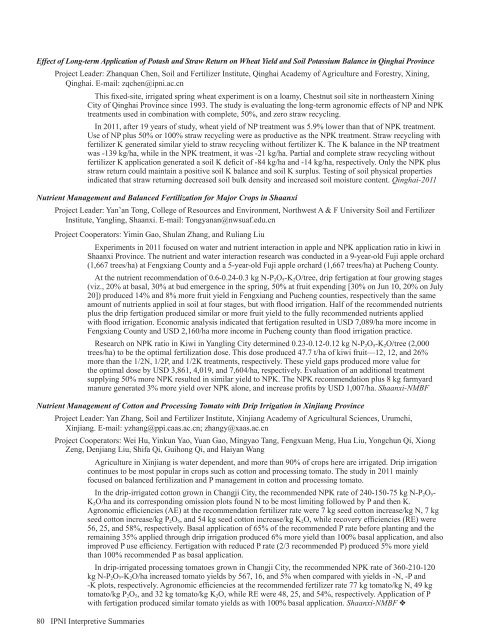Americas and Oceania Group - International Plant Nutrition Institute
Americas and Oceania Group - International Plant Nutrition Institute
Americas and Oceania Group - International Plant Nutrition Institute
Create successful ePaper yourself
Turn your PDF publications into a flip-book with our unique Google optimized e-Paper software.
Effect of Long-term Application of Potash <strong>and</strong> Straw Return on Wheat Yield <strong>and</strong> Soil Potassium Balance in Qinghai Province<br />
Project Leader: Zhanquan Chen, Soil <strong>and</strong> Fertilizer <strong>Institute</strong>, Qinghai Academy of Agriculture <strong>and</strong> Forestry, Xining,<br />
Qinghai. E-mail: zqchen@ipni.ac.cn<br />
This fixed-site, irrigated spring wheat experiment is on a loamy, Chestnut soil site in northeastern Xining<br />
City of Qinghai Province since 1993. The study is evaluating the long-term agronomic effects of NP <strong>and</strong> NPK<br />
treatments used in combination with complete, 50%, <strong>and</strong> zero straw recycling.<br />
In 2011, after 19 years of study, wheat yield of NP treatment was 5.9% lower than that of NPK treatment.<br />
Use of NP plus 50% or 100% straw recycling were as productive as the NPK treatment. Straw recycling with<br />
fertilizer K generated similar yield to straw recycling without fertilizer K. The K balance in the NP treatment<br />
was -139 kg/ha, while in the NPK treatment, it was -21 kg/ha. Partial <strong>and</strong> complete straw recycling without<br />
fertilizer K application generated a soil K deficit of -84 kg/ha <strong>and</strong> -14 kg/ha, respectively. Only the NPK plus<br />
straw return could maintain a positive soil K balance <strong>and</strong> soil K surplus. Testing of soil physical properties<br />
indicated that straw returning decreased soil bulk density <strong>and</strong> increased soil moisture content. Qinghai-2011<br />
Nutrient Management <strong>and</strong> Balanced Fertilization for Major Crops in Shaanxi<br />
Project Leader: Yan’an Tong, College of Resources <strong>and</strong> Environment, Northwest A & F University Soil <strong>and</strong> Fertilizer<br />
<strong>Institute</strong>, Yangling, Shaanxi. E-mail: Tongyanan@nwsuaf.edu.cn<br />
Project Cooperators: Yimin Gao, Shulan Zhang, <strong>and</strong> Ruliang Liu<br />
Experiments in 2011 focused on water <strong>and</strong> nutrient interaction in apple <strong>and</strong> NPK application ratio in kiwi in<br />
Shaanxi Province. The nutrient <strong>and</strong> water interaction research was conducted in a 9-year-old Fuji apple orchard<br />
(1,667 trees/ha) at Fengxiang County <strong>and</strong> a 5-year-old Fuji apple orchard (1,667 trees/ha) at Pucheng County.<br />
At the nutrient recommendation of 0.6-0.24-0.3 kg N-P 2 O 5 -K 2 O/tree, drip fertigation at four growing stages<br />
(viz., 20% at basal, 30% at bud emergence in the spring, 50% at fruit expending [30% on Jun 10, 20% on July<br />
20]) produced 14% <strong>and</strong> 8% more fruit yield in Fengxiang <strong>and</strong> Pucheng counties, respectively than the same<br />
amount of nutrients applied in soil at four stages, but with flood irrigation. Half of the recommended nutrients<br />
plus the drip fertigation produced similar or more fruit yield to the fully recommended nutrients applied<br />
with flood irrigation. Economic analysis indicated that fertigation resulted in USD 7,089/ha more income in<br />
Fengxiang County <strong>and</strong> USD 2,160/ha more income in Pucheng county than flood irrigation practice.<br />
Research on NPK ratio in Kiwi in Yangling City determined 0.23-0.12-0.12 kg N-P 2 O 5 -K 2 O/tree (2,000<br />
trees/ha) to be the optimal fertilization dose. This dose produced 47.7 t/ha of kiwi fruit—12, 12, <strong>and</strong> 26%<br />
more than the 1/2N, 1/2P, <strong>and</strong> 1/2K treatments, respectively. These yield gaps produced more value for<br />
the optimal dose by USD 3,861, 4,019, <strong>and</strong> 7,604/ha, respectively. Evaluation of an additional treatment<br />
supplying 50% more NPK resulted in similar yield to NPK. The NPK recommendation plus 8 kg farmyard<br />
manure generated 3% more yield over NPK alone, <strong>and</strong> increase profits by USD 1,007/ha. Shaanxi-NMBF<br />
Nutrient Management of Cotton <strong>and</strong> Processing Tomato with Drip Irrigation in Xinjiang Province<br />
Project Leader: Yan Zhang, Soil <strong>and</strong> Fertilizer <strong>Institute</strong>, Xinjiang Academy of Agricultural Sciences, Urumchi,<br />
Xinjiang. E-mail: yzhang@ppi.caas.ac.cn; zhangy@xaas.ac.cn<br />
Project Cooperators: Wei Hu, Yinkun Yao, Yuan Gao, Mingyao Tang, Fengxuan Meng, Hua Liu, Yongchun Qi, Xiong<br />
Zeng, Denjiang Liu, Shifa Qi, Guihong Qi, <strong>and</strong> Haiyan Wang<br />
Agriculture in Xinjiang is water dependent, <strong>and</strong> more than 90% of crops here are irrigated. Drip irrigation<br />
continues to be most popular in crops such as cotton <strong>and</strong> processing tomato. The study in 2011 mainly<br />
focused on balanced fertilization <strong>and</strong> P management in cotton <strong>and</strong> processing tomato.<br />
In the drip-irrigated cotton grown in Changji City, the recommended NPK rate of 240-150-75 kg N-P 2 O 5 -<br />
K 2 O/ha <strong>and</strong> its corresponding omission plots found N to be most limiting followed by P <strong>and</strong> then K.<br />
Agronomic efficiencies (AE) at the recommendation fertilizer rate were 7 kg seed cotton increase/kg N, 7 kg<br />
seed cotton increase/kg P 2 O 5 , <strong>and</strong> 54 kg seed cotton increase/kg K 2 O, while recovery efficiencies (RE) were<br />
56, 25, <strong>and</strong> 58%, respectively. Basal application of 65% of the recommended P rate before planting <strong>and</strong> the<br />
remaining 35% applied through drip irrigation produced 6% more yield than 100% basal application, <strong>and</strong> also<br />
improved P use efficiency. Fertigation with reduced P rate (2/3 recommended P) produced 5% more yield<br />
than 100% recommended P as basal application.<br />
In drip-irrigated processing tomatoes grown in Changji City, the recommended NPK rate of 360-210-120<br />
kg N-P 2 O5-K 2 O/ha increased tomato yields by 567, 16, <strong>and</strong> 5% when compared with yields in -N, -P <strong>and</strong><br />
-K plots, respectively. Agronomic efficiencies at the recommended fertilizer rate 77 kg tomato/kg N, 49 kg<br />
tomato/kg P 2 O 5 , <strong>and</strong> 32 kg tomato/kg K 2 O, while RE were 48, 25, <strong>and</strong> 54%, respectively. Application of P<br />
with fertigation produced similar tomato yields as with 100% basal application. Shaanxi-NMBF v<br />
80 IPNI Interpretive Summaries

















